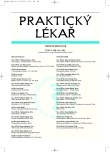Severely visually handicapped people at general practitioners
Těžce zrakově postižení v ordinaci praktických lékařů
Cíl:
Zjistit zkušenosti těžce zrakově postižených (TZP), praktických lékařů (PL) a zdravotních sester (ZS) s jejich vzájemnou komunikací. Zmapovat informovanost PL o zásadách přístupu k TZP a vyhodnotit pohled TZP na tuto problematiku. Upozornit na největší problémy běžného života TZP, na nejčastější předsudky a chyby vidoucích v komunikaci s nimi.
Soubor a metodika:
Výzkumu se zúčastnilo deset soukromých PL pro dospělé v Hradci Králové. Oslovili jsme 5 nevidomých. Praktičtí lékaři vyplňovali anonymní dotazník, s TZP jsme vedli řízený rozhovor se záznamem.
Výsledky:
Z deseti dotázaných PL se s TZP ve své ordinaci setkalo osm z nich. Všichni PL (n = 10) odpověděli správně na dotaz týkající se zásad vedení nevidomého, avšak pouze jeden uvedl správně názvy a sídla dvou organizací v Hradci Králové, které nabízejí pomoc lidem se zrakovým handicapem. Dotázaní TZP hodnotí vzájemný vztah s PL nyní jako uspokojivý. Všichni nevidomí respondenti (n = 5) však nacházejí obtíže v komunikaci se zdravotní sestrou v ordinaci PL. Čtyři z pěti TZP si myslí, že by se zdravotnický personál měl dále vzdělávat v dané problematice. Největší obtíže mají TZP s orientací v prostoru, komunikací s veřejností a informačním deficitem. Nejvíce se setkávají s podceňujícími předsudky.
Závěr:
Z našeho výzkumu vyplývá, že komunikace mezi dotázanými TZP a PL byla a je uspokojivá, větší rezervy byly odhaleny spíše v komunikaci TZP a zdravotních sester.
Klíčová slova:
těžce zrakově postižený, komunikace, praktický lékař
Authors:
J. Nekolová; J. Pozlerová; N. Jirásková; J. Kadlecová; P. Rozsíval
Authors‘ workplace:
Přednosta prof. MUDr. Pavel Rozsíval, CSc.
; Oční klinika LF UK a FN Hradec Králové
Published in:
Prakt. Lék. 2006; 86(8): 454-456
Category:
Of different specialties
Overview
Aim:
To find out the experience of severely visually handicapped (SVH) people, General Practitioners (GPs) and their nurses (Ns) in mutual communication. To obtain general information on how the GPs are acquainted with methods of working effectively with the SVH and to learn SVH respondents’ opinion on it. To point out the most common problems of blind peoples’ everyday life, ingrained prejudices and mistakes that sighted people can make in helping those with little or no sight.
Methods:
Ten GPs working in Hradec Králové were asked to fill in an anonymous questionnaire and a recorded interview was done with five SVH people.
Results:
Eight out of the ten GPs have already seen the SVH patient at their surgeries. All of the GPs (n = 10) correctly answered a question about the principles of assisting and guiding SVH person but only one knew 2 organisations that help blind or visually impaired people in Hradec Králové. All of the SVH respondents (n = 5) said that there was a good relationship between them and their GP, but they mentioned communication problems with Nurses. Four of the five SVH respondents think that medical staff should undergo further training in this field. The most prevalent problems blind and visually impaired people have to face are orientation, communication with sighted people and a lack of information. They most often find that people underestimate their abilities.
Conclusion:
According to our research, communication between Severely Visually Handicapped people and their General Practitioners has been satisfactory, contrary to communication with Nurses at their surgeries.
Key words:
severely visually handicapped, communication, general practitioner
Labels
General practitioner for children and adolescents General practitioner for adultsArticle was published in
General Practitioner

2006 Issue 8
- Metamizole vs. Tramadol in Postoperative Analgesia
- Metamizole at a Glance and in Practice – Effective Non-Opioid Analgesic for All Ages
- Memantine in Dementia Therapy – Current Findings and Possible Future Applications
- Advances in the Treatment of Myasthenia Gravis on the Horizon
- Hope Awakens with Early Diagnosis of Parkinson's Disease Based on Skin Odor
Most read in this issue
- Contraception and surgery
- Anaerobic sepsis: Lemierre syndrome
- Stroke and myocardial infarction – parallels and paradoxes
- Tuberculosis at the present
